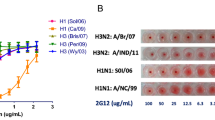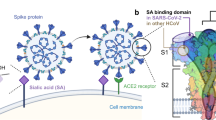Abstract
The HIV-1 envelope, gp120, which features the binding determinants for both CD4 and coreceptor recognition, is key for virus entry and represents an attractive pharmacological target. However, critical domains for entry (coreceptor and CD4 binding sites) are either cryptic or located in partially occluded cavities. Here we developed a chemical approach to synthesize a CD4-mimetic peptide linked to a heparan sulfate dodecasaccharide. This molecule binds to gp120, induces the exposure of the coreceptor binding domain and renders it available for interaction with the oligosaccharide. The linkage between the CD4 mimetic and the heparan sulfate derivative provides strong cooperative effects, resulting in low-nanomolar antiviral activity toward both CCR5- and CXCR4-tropic HIV-1 strains. This compound, which has the unique ability to simultaneously target two critical and highly conserved regions of gp120, establishes a new type of inhibitor and suggests a general concept for the inhibition of numerous other biological systems.
This is a preview of subscription content, access via your institution
Access options
Subscribe to this journal
Receive 12 print issues and online access
$259.00 per year
only $21.58 per issue
Buy this article
- Purchase on Springer Link
- Instant access to full article PDF
Prices may be subject to local taxes which are calculated during checkout



Similar content being viewed by others
References
Barre-Sinoussi, F. et al. Isolation of a T-lymphotropic retrovirus from a patient at risk for acquired immune deficiency syndrome (AIDS). Science 220, 868–871 (1983).
Shafer, R.W. & Schapiro, J.M. HIV-1 drug resistance mutations: an updated framework for the second decade of HAART. AIDS Rev. 10, 67–84 (2008).
Flexner, C. HIV drug development: the next 25 years. Nat. Rev. Drug Discov. 6, 959–966 (2007).
Klatzmann, D. et al. T-lymphocyte T4 molecule behaves as the receptor for human retrovirus LAV. Nature 312, 767–768 (1984).
Alkhatib, G. et al. CC CKR5: a RANTES, MIP-1alpha, MIP-1beta receptor as a fusion cofactor for macrophage-tropic HIV-1. Science 272, 1955–1958 (1996).
Feng, Y., Broder, C.C., Kennedy, P.E. & Berger, E.A. HIV-1 entry cofactor: functional cDNA cloning of a seven-transmembrane, G protein-coupled receptor. Science 272, 872–877 (1996).
Berger, E.A., Murphy, P.M. & Farber, J.M. Chemokine receptors as HIV-1 coreceptors: roles in viral entry, tropism, and disease. Annu. Rev. Immunol. 17, 657–700 (1999).
Chen, B. et al. Structure of an unliganded simian immunodeficiency virus gp120 core. Nature 433, 834–841 (2005).
Kwong, P.D. et al. Structure of an HIV gp120 envelope glycoprotein in complex with the CD4 receptor and a neutralizing human antibody. Nature 393, 648–659 (1998).
Hartley, O., Klasse, P.J., Sattentau, Q.J. & Moore, J.P. V3: HIV's switch-hitter. AIDS Res. Hum. Retroviruses 21, 171–189 (2005).
Rizzuto, C.D. et al. A conserved HIV gp120 glycoprotein structure involved in chemokine receptor binding. Science 280, 1949–1953 (1998).
Bishop, J.R., Schuksz, M. & Esko, J.D. Heparan sulphate proteoglycans fine-tune mammalian physiology. Nature 446, 1030–1037 (2007).
Endress, T. et al. HIV-1-cellular interactions analyzed by single virus tracing. Eur. Biophys. J. 37, 1291–1301 (2008).
de Witte, L. et al. Syndecan-3 is a dendritic cell-specific attachment receptor for HIV-1. Proc. Natl. Acad. Sci. USA 104, 19464–19469 (2007).
Rider, C.C. et al. Anti-HIV-1 activity of chemically modified heparins: correlation between binding to the V3 loop of gp120 and inhibition of cellular HIV-1 infection in vitro. Biochemistry 33, 6974–6980 (1994).
Roderiquez, G. et al. Mediation of human immunodeficiency virus type 1 binding by interaction of cell surface heparan sulfate proteoglycans with the V3 region of envelope gp120-gp41. J. Virol. 69, 2233–2239 (1995).
Moulard, M. et al. Selective interactions of polyanions with basic surfaces on human immunodeficiency virus type 1 gp120. J. Virol. 74, 1948–1960 (2000).
Crublet, E., Andrieu, J.P., Vives, R.R. & Lortat-Jacob, H. The HIV-1 envelope glycoprotein gp120 features four heparan sulfate binding domains, including the co-receptor binding site. J. Biol. Chem. 283, 15193–15200 (2008).
Vives, R.R., Imberty, A., Sattentau, Q.J. & Lortat-Jacob, H. Heparan sulfate targets the HIV-1 envelope glycoprotein gp120 coreceptor binding site. J. Biol. Chem. 280, 21353–21357 (2005).
Pierson, T.C. & Doms, R.W. HIV-1 entry and its inhibition. Curr. Top. Microbiol. Immunol. 281, 1–27 (2003).
Huang, C.C. et al. Scorpion-toxin mimics of CD4 in complex with human immunodeficiency virus gp120 crystal structures, molecular mimicry, and neutralization breadth. Structure 13, 755–768 (2005).
Adibekian, A. et al. De novo synthesis of uronic acid building blocks for assembly of heparin oligosaccharides. Chemistry (Easton) 13, 4510–4522 (2007).
Lubineau, A., Lortat-Jacob, H., Gavard, O., Sarrazin, S. & Bonnaffe, D. Synthesis of tailor-made glycoconjugate mimetics of heparan sulfate that bind IFN-gamma in the nanomolar range. Chemistry (Easton) 10, 4265–4282 (2004).
Petitou, M. & van Boeckel, C.A. A synthetic antithrombin III binding pentasaccharide is now a drug! What comes next? Angew. Chem. Int. Edn Engl. 43, 3118–3133 (2004).
Xiang, S.H., Doka, N., Choudhary, R.K., Sodroski, J. & Robinson, J.E. Characterization of CD4-induced epitopes on the HIV type 1 gp120 envelope glycoprotein recognized by neutralizing human monoclonal antibodies. AIDS Res. Hum. Retroviruses 18, 1207–1217 (2002).
Choe, H. et al. Tyrosine sulfation of human antibodies contributes to recognition of the CCR5 binding region of HIV-1 gp120. Cell 114, 161–170 (2003).
Huang, C.C. et al. Structures of the CCR5 N terminus and of a tyrosine-sulfated antibody with HIV-1 gp120 and CD4. Science 317, 1930–1934 (2007).
Roisin, A. et al. Inhibition of HIV-1 replication by cell-penetrating peptides binding Rev. J. Biol. Chem. 279, 9208–9214 (2004).
Labrijn, A.F. et al. Access of antibody molecules to the conserved coreceptor binding site on glycoprotein gp120 is sterically restricted on primary human immunodeficiency virus type 1. J. Virol. 77, 10557–10565 (2003).
Chen, W., Zhu, Z., Feng, Y. & Dimitrov, D.S. Human domain antibodies to conserved sterically restricted regions on gp120 as exceptionally potent cross-reactive HIV-1 neutralizers. Proc. Natl. Acad. Sci. USA 105, 17121–17126 (2008).
Saidi, H., Magri, G., Nasreddine, N., Requena, M. & Belec, L. R5- and X4-HIV-1 use differentially the endometrial epithelial cells HEC-1A to ensure their own spread: implication for mechanisms of sexual transmission. Virology 358, 55–68 (2007).
Argyris, E.G. et al. Human immunodeficiency virus type 1 enters primary human brain microvascular endothelial cells by a mechanism involving cell surface proteoglycans independent of lipid rafts. J. Virol. 77, 12140–12151 (2003).
Moncunill, G., Armand-Ugon, M., Pauls, E., Clotet, B. & Este, J.A. HIV-1 escape to CCR5 coreceptor antagonism through selection of CXCR4-using variants in vitro. AIDS 22, 23–31 (2008).
Chan, W.C. & White, P.D. Fmoc Solid Phase Peptide Synthesis, a Practical Approach (Oxford University Press, Oxford, 2000).
Gartner, S. et al. The role of mononuclear phagocytes in HTLV-III/LAV infection. Science 233, 215–219 (1986).
Kärber, G. Beitrag zur kollektiven behandlung pharmakologischer reihenversuche. Arch. Exp. Path. Pharmak. 162, 480–483 (1931).
Thali, M. et al. Characterization of conserved human immunodeficiency virus type 1 gp120 neutralization epitopes exposed upon gp120–CD4 binding. J. Virol. 67, 3978–3988 (1993).
Acknowledgements
We thank L. Klemm, C. Rogez-Kreuz, R. Yousfi and V. Huyot for technical assistance and R.R. Vivès for stimulating discussions. This work was supported by the Agence Nationale de la Recherche sur le Syndrome d'Immunodficience Acquise. Soluble CD4 and monoclonal antibodies 17b and E51 were obtained through the US National Institutes of Health AIDS Research and Reference Reagent Program from S. Iyer and J. Robinson. Infectious HIV-1 proviral clones pNL4-3 Luc were a gift from J. Alcami (Unidad de Inmunopatologa del Sida, Instituto de Salud Carlos III).
Author information
Authors and Affiliations
Contributions
H.L.-J. developed the hypotheses; F.B., D.B. and H.L.-J. designed the project and wrote the manuscript; F.B., D.B., L.L.-M. and Y.H. synthesized and characterized the molecules; H.L.-J. performed the binding studies; P.C. and F.A.-S. performed the antiviral analyses.
Corresponding author
Supplementary information
Supplementary Text and Figures
Supplementary Figures 1–4, Supplementary Schemes 1–3, Supplementary Table 1 and Supplementary Methods (PDF 2736 kb)
Rights and permissions
About this article
Cite this article
Baleux, F., Loureiro-Morais, L., Hersant, Y. et al. A synthetic CD4–heparan sulfate glycoconjugate inhibits CCR5 and CXCR4 HIV-1 attachment and entry. Nat Chem Biol 5, 743–748 (2009). https://doi.org/10.1038/nchembio.207
Received:
Accepted:
Published:
Issue Date:
DOI: https://doi.org/10.1038/nchembio.207
This article is cited by
-
CD4-mimetic sulfopeptide conjugates display sub-nanomolar anti-HIV-1 activity and protect macaques against a SHIV162P3 vaginal challenge
Scientific Reports (2016)
-
Structural requirements of glycosaminoglycans for their interaction with HIV-1 envelope glycoprotein gp120
Archives of Virology (2014)
-
Tetrasaccharide iteration synthesis of a heparin-like dodecasaccharide and radiolabelling for in vivo tissue distribution studies
Nature Communications (2013)
-
Synthesis of 3-O-sulfonated heparan sulfate octasaccharides that inhibit the herpes simplex virus type 1 host–cell interaction
Nature Chemistry (2011)



